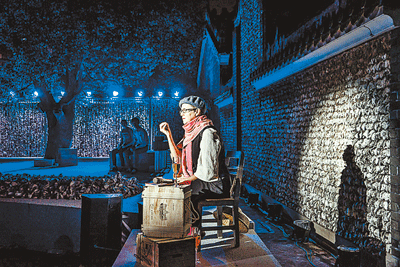 Tan Yifan cicitan2011@gmail.com YANG QIAN, a Shenzhen-based artist and scriptwriter, discussed the origin of the city with his team Shenzhen Fatbird Troupe last week at Shajing’s Jiang Ancestor Hall in Bao’an District by staging a newly produced Sino-French drama “The Romance of Oysters and Champagne.” A thinker and a cultural preserver, Yang questioned the attempts of the organizers of this year’s Bi-City Biennale of Urbanism and Architecture (UABB), challenging their thoughts on the city’s origin — the theme of this year’s UABB. “It is questionable to set the main venue of UABB at Shekou and discuss the origin of the city there,” Yang said. “The setting there seems to hint that Shenzhen only has a history of 30 years. But in fact the city was established hundreds of years ago [in the year 1573 — Ming Dynasty], and its origin should be in here — Shajing [where ancient residents lived and raised oysters]. Also, communication between local people and expats started ages ago.” Yang said he also wanted to remind people the price we paid for urbanism. “What are we really [both the architects and city builders]? Is it worthwhile to build a city at the price of the disappearance of the old things?” Yang added. It was with such concerns Yang invited French director and choreographer Myriam Herve-Gil to Shenzhen and discussed the possibility of cooperating on the drama. Immersed in Shajing’s oyster culture and the beauty of French champagne, Yang and Herve-Gil decided to create the experimental play and narrate a romantic story of a Chinese pearl-hunting girl and a French poet. They conducted research in both countries and invited actors and actresses with different cultural backgrounds — French, Chinese and American performers — to present the drama in their own language. The story unfolds as a French professor visits a southern Chinese island, trying to find a trace of a legendary story. With the help of a local policewoman, whose grandmother was the last pearl-hunting girl, the French professor finds a sunken ship covered with oyster shells. The professor thinks the sunken ship belongs to a famous French poet who might have lived during the Yuan Dynasty (1271-1368), but it turns out that the boat belongs to a French national who visited the island in the 1950s. No one knows what happened to the owner of the boat — only stories are left. The legend of the French poet says that the Emperor of the Mongols, Yekenayan, once invited the poet to his palace. Yekenayan gave the poet one year to write a poem celebrating his conquest. The poet left the capital three times and brought back his “poems.” The first time he brought the emperor a pearl-hunting girl and the emperor married her. The second time he brought back empty champagne bottles, which had sunk with his boat. The third time he brought back live oysters. During his trips, the poet fell in love with a pearl-hunting girl who saved his life. He was finally allowed to live a happy life with the girl. While sharing the legend with the policewoman, the French professor discovers that the village where the secret French man lived in the 1950s was replaced by a fancy new development, and the policewoman almost forgets her family origins. As the relationship between the companions grows deeper, the policewoman struggles to accept her origins and decides to seek her family traditions and the village. Details of the drama, such as the venue, the oyster shell setting, the oyster shell walls, the languages it presented — Cantonese, Putonghua and English [the French actor left China after the debut] — the sea wave sounds made by the performers’ feet and a background recording of an old lady singing a song in Shajing dialect all made the show unique among today’s stage arts. As Yang expected, viewers were amazed by the venue — a century-old, oyster shell ancestor hall — and were shocked by the play’s themes, which questioned the autocracy power, reformation and construction, the preservation of culture and nature and the relationships between local people and outsiders in view of political ideology. But the one-hour experimental drama also left some regrets among audience. Some viewers said there was a lack of dramatic conflict, the narrative was too long and the different languages were a barrier to them. It was performed for three consecutive days and before each performance, Yang invited experts from various fields to give lectures on history, nature protection, art and city construction. The drama will be presented again in France in the coming year. | 
